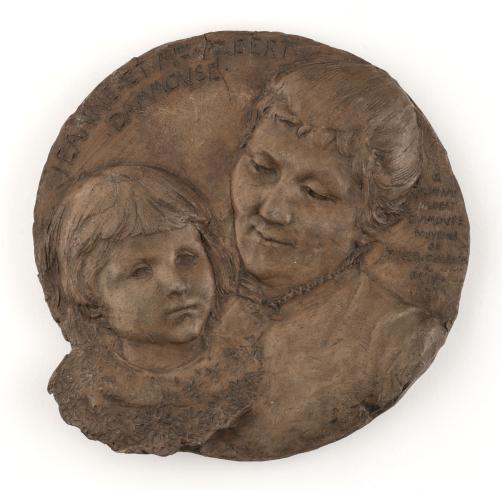Like numerous sculptors of his generation, Jean-Désiré Ringel, known as Ringel d’Illzach, was interested in medallion art.
Originally from Alsace, Ringel d’Illzach trained in Paris where he studied both music and art simultaneously. He was a student of the sculptors François Jouffroy and Alexandre Falguière and devoted himself solely to sculpture after the war of 1870. He exhibited work at the Salon on a regular basis and demonstrated a preference for polychrome materials, in particular coloured wax, ceramics and vitreous paste.
The two inscriptions engraved on the medallion date the work from 1885 and identify the models as Madame Dammouse and her daughter, Jeanne. The medallion is dedicated “to my friend Albert Dammouse, a memento of Ringel d’Illzach”. Albert Dammouse was the son of a sculptor at the Sèvres Manufacture and, like Ringel d’Illzach, had attended Jouffroy’s studio at the École des Beaux-Arts before devoting himself to ceramics. In 1885 he worked with Haviland who entrusted him with the creation of his decorated stoneware vases. In the studio managed by Ernest Chaplet on Rue Blomet, Dammouse met Ringel d’Illzach, who made models for the Haviland factory there. The ceramicist and the sculptor began a lasting partnership, and in 1897 Ringel d’Illzach experimented with a glass moulding technique in Dammouse’s studio in Sèvres.
The medallion given to the Petit Palais testifies to the connection between the two men. It is a very personal portrait which does not seem to have been reproduced or distributed through copies, since no other copy has been recorded to this day. Ringel d’Illzach may have modelled the portrait of the wife and daughter of his friend and fellow student directly, in thanks for a service rendered or as a simple token of his appreciation, as was common practice in the 19th century.
C. C.-V.

City of Paris municipal collection's website
The collections portal can be used to search the collections of Paris’s 14 municipal museums (approximately 336,000 works, including 43,000 belonging to the Petit Palais).
It is also possible to download around 12,000 images of the museum’s works free of charge.
Access the Museums of the City of Paris collections portal
Extern databases
Discover a selection of databases online presenting works from the Petit Palais or documents concerning the history of the museum.

